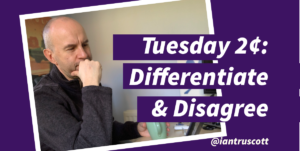In B2B marketing it’s commercially safer to be different than joining the morass of B2Boring messaging, in this Tuesday 2 cents I look at how we do that, by disagreeing…
As marketers our work has to stand out, to create differentiation, maybe even disrupt a little.
In our content marketing, taking a firm point of view, differentiating from the crowd enables us to find or create a tribe of like-minded people, moving our product or service from the long list of dull vendors talking fluent business speak to a short list of their kind of people, speaking their language, passionate about the same things.
The problem is organizations often start these messaging projects by researching the competition and picking what they like and because of the source of the research (the goldfish bowl of other vendors in the space) they create something iterative and dull, that looks like everything else. However, because it looks and sounds kinda right for the category, it offends no one.
It’s the easier path, I’ve previous written about this, try to be different and you hit the resistance and the immune system of the company springs into action and it becomes so much easier to unveil a light refresh of the website and some moderately updated copy, that no-one objects to.
The buyer, meanwhile, is confronted by a confusing sea of “me too” to choose between.
The key to beating the resistance is bringing the leadership with you early on this differentiating journey, to develop a brand story and a corporate point of view (not just a marketing message) that authentically resonates within the company and reflects the products and level of service the customer can expect.
A good place to start is to think about what you, as a leadership team, disagree with in your industry.
In my last company (censhare) we collectively disagreed with how content is managed in silos in organizations. This simple statement was something that authentically reflected the product and service the company provided, but this “no-silo” idea became a rallying cry for the team and the backbone of our brand story, elevator pitch, campaigns and marketing messaging.
Of course, this was standing on the shoulders of giants as Marc Benioff built Salesforce on the back of disagreeing with legacy software with his No-Software brand story.
(Oh, for those of you dealing with the resistance, note how in this article he refers to how everyone hated it at first!).
If we take a more story telling approach, this thing you disagree with could be the villain of your brand story, to learn more about that I suggest this article by content marketing guru Robert Rose.
So, this Tuesday, figure out what you disagree with, find a common villain in your brand story and tell a different story.
Fancy more of this?
Subscribe to my Rockstar CMO Newsletter

I’m a 3xCMO, now a marketing strategy advisor and podcast host at Rockstar CMO. Although, I’m not a rock star, but a marketing leader, strategist, content marketer, columnist, speaker, industry watcher, and creator of ART (Awareness, Revenue, and Trust) for the companies I work with. But most of all, I am an enthusiastic tea drinker.
You can find me on LinkedIn, Twitter, or now Threads! – or listen to my weekly podcast at Rockstarcmo.com
The half-baked thoughts shared on this blog may not reflect those of my employer or clients, and if the topic of this article is interesting or you just want to say hello please get in touch.
